Abstract
Epstein-Barr-virus-transformed B lymphoblastoid cell lines (EBV-transformed LCL) from three patients with X-linked agammaglobulinaemia (XLA), six patients with Wiskott-Aldrich Syndrome (WAS), and seven normal donors, were tested for growth and differentiation in response to human recombinant IL-4, a commercially available, low molecular weight B cell growth factor (BCGFlow), and B cell differentiation factor (BCDF) secreted by the T24 cell line, now known to be IL-6. Proliferation (3H-TdR uptake) by EBV-transformed LCL from both XLA and WAS patients in response to BCGFlow was similar to that obtained with the normal cell lines. In addition, three normal and three WAS, but none of the XLA EBV-transformed LCL, proliferated a little in response to IL-4. All the normal B cell lines secreted IgM, and six out of the seven secreted IgG in response to BCGFlow and BCDF. A similar pattern of response was obtained with the WAS EBV-transformed LCL (6/6 secreted IgM and 4/6 secreted IgG). Several of the normal and WAS EBV-transformed LCL also secreted IgM and IgG in response to IL-4. In contrast, the lines from the XLA patients were abnormal. One secreted large amounts of IgM and two secreted small amounts, but none of the XLA lines secreted IgG constitutively or in response to any of the factors (IL-4, BCDF). The lack of detectable IgG secretion by the XLA lines was probably due to an absence of precommitted IgG B cell precursors transformed by EBV rather than an intrinsic inability to respond to BCGF and BCDF. All of the lines, including those derived from XLA patients, were shown to secrete B cell growth and differentiation factors detected on indicator B cell lines. These results suggest that the abnormal X-linked genes responsible for XLA and WAS do not interfere with B cell responses to B cell growth and differentiation factors.
Full text
PDF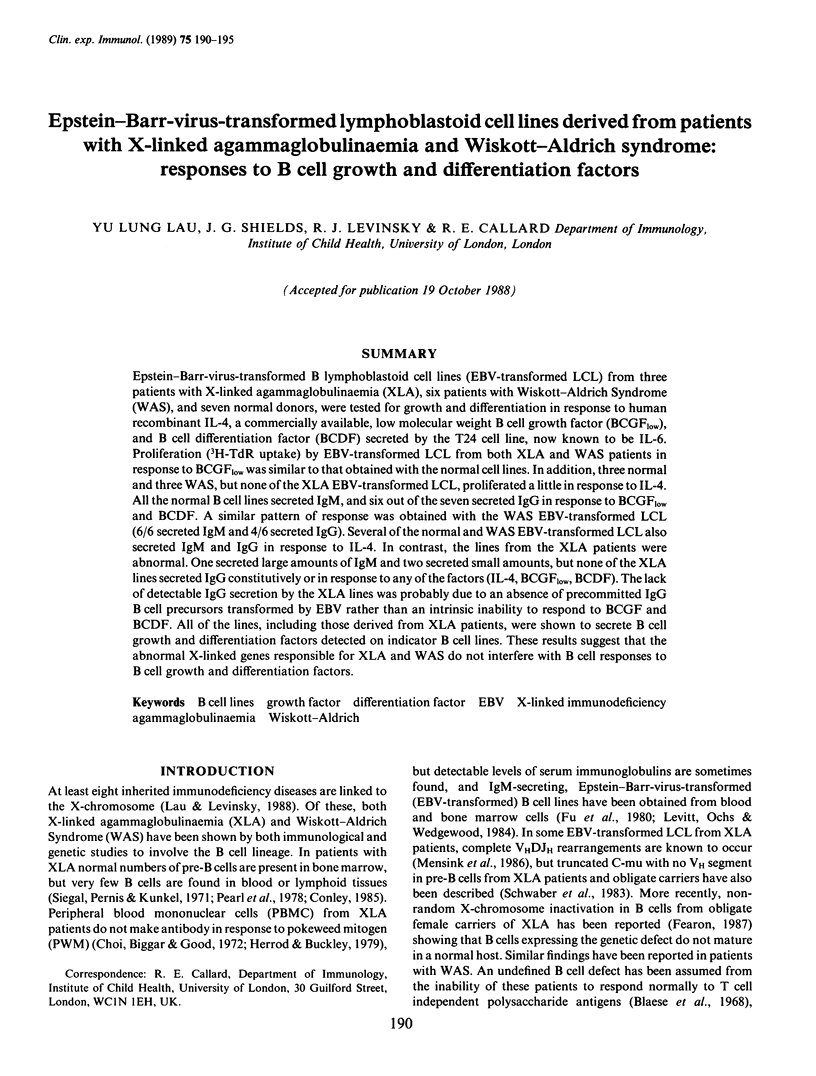
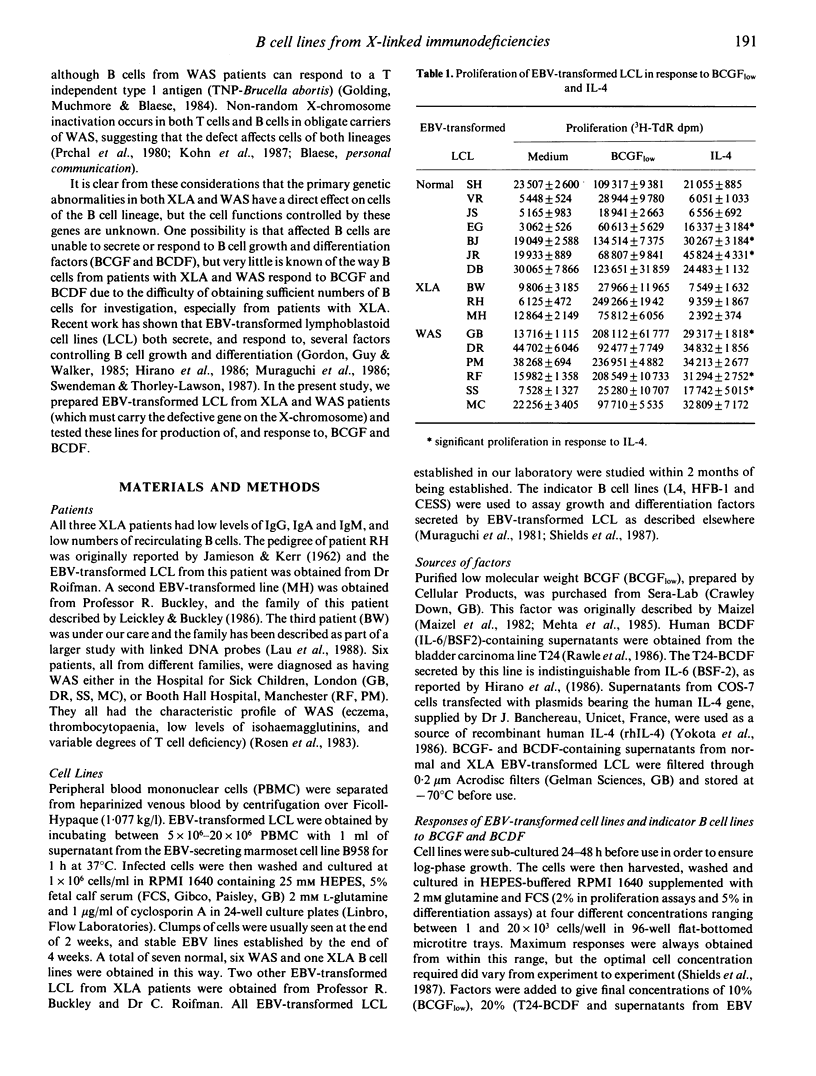
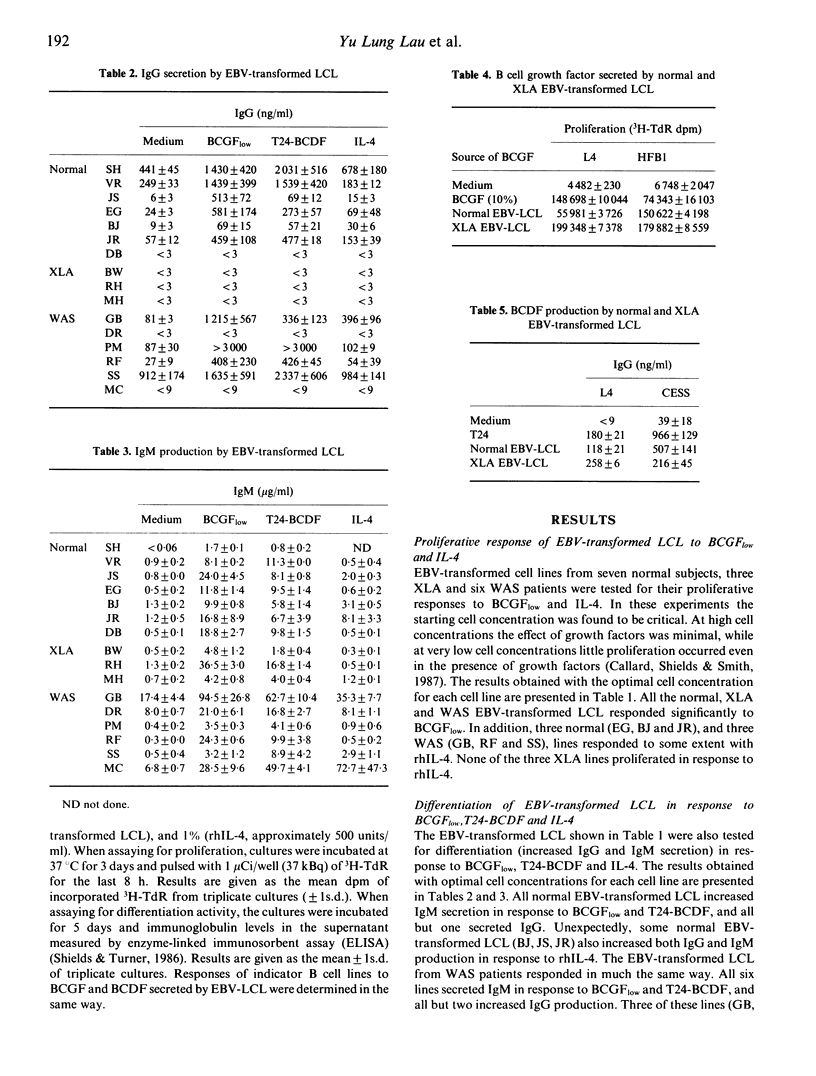
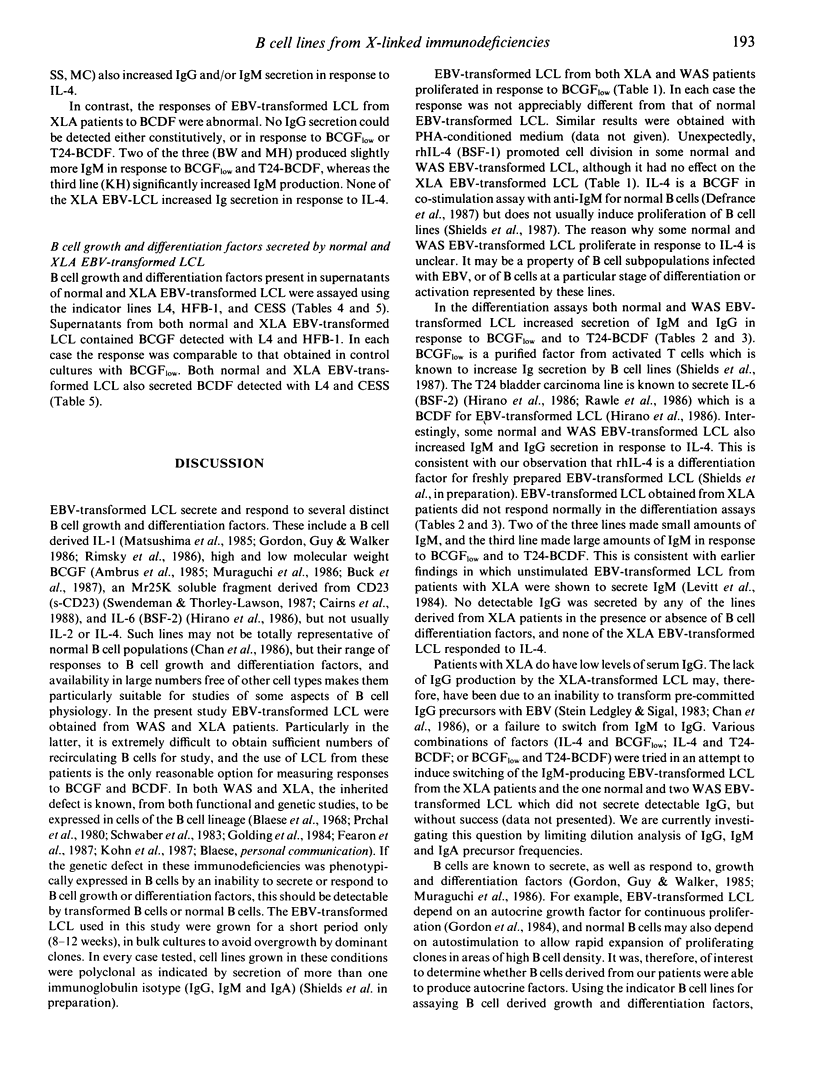
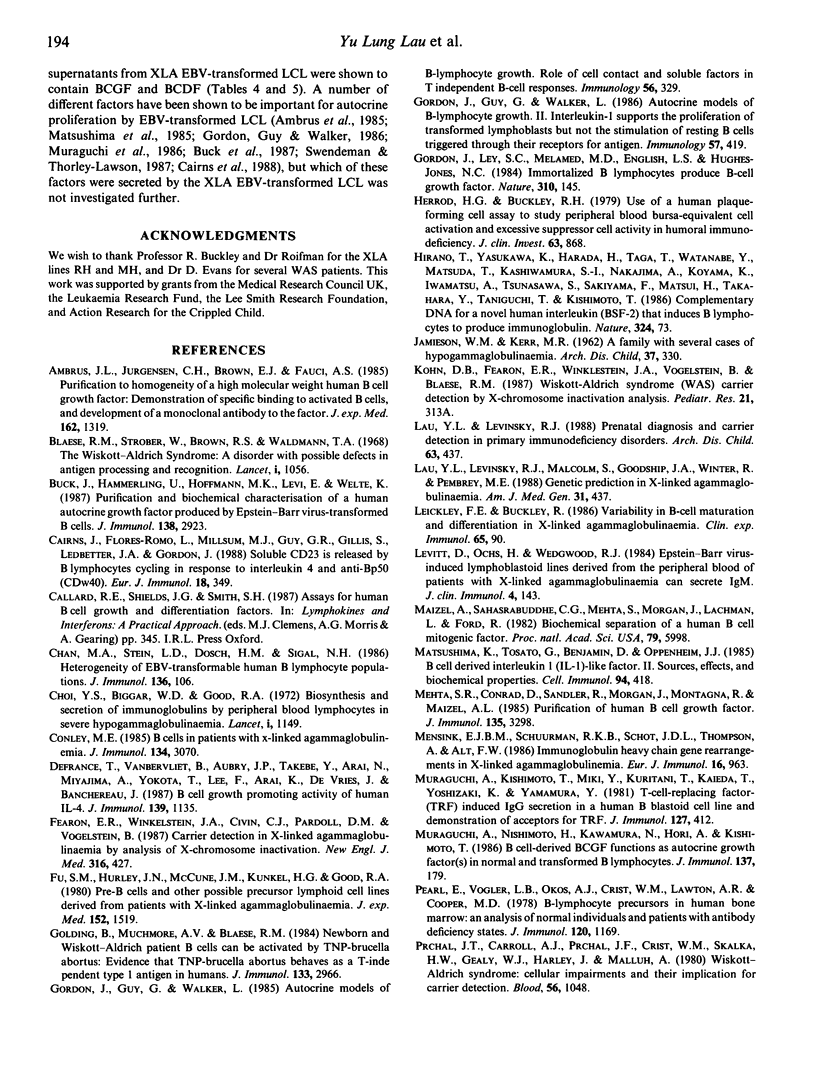
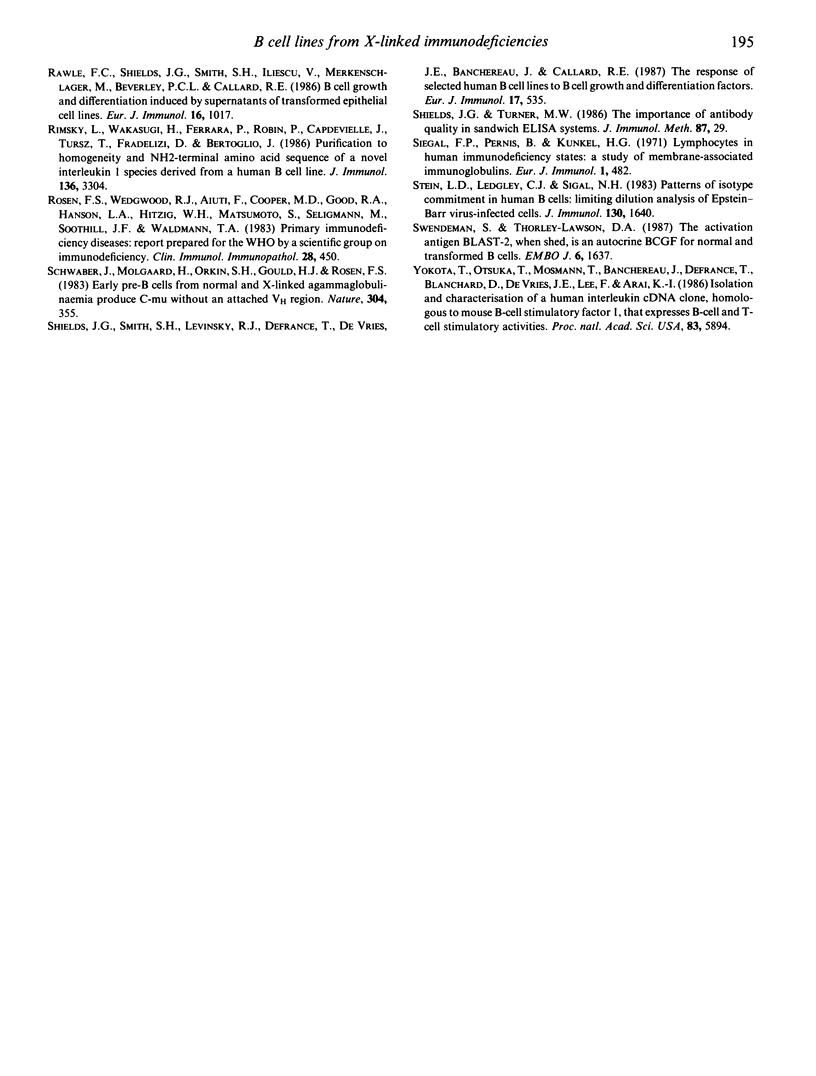
Selected References
These references are in PubMed. This may not be the complete list of references from this article.
- Ambrus J. L., Jr, Jurgensen C. H., Brown E. J., Fauci A. S. Purification to homogeneity of a high molecular weight human B cell growth factor; demonstration of specific binding to activated B cells; and development of a monoclonal antibody to the factor. J Exp Med. 1985 Oct 1;162(4):1319–1335. doi: 10.1084/jem.162.4.1319. [DOI] [PMC free article] [PubMed] [Google Scholar]
- Blaese R. M., Strober W., Brown R. S., Waldmann T. A. The Wiskott-Aldrich syndrome. A disorder with a possible defect in antigen processing or recognition. Lancet. 1968 May 18;1(7551):1056–1061. doi: 10.1016/s0140-6736(68)91411-6. [DOI] [PubMed] [Google Scholar]
- Buck J., Hämmerling U., Hoffmann M. K., Levi E., Welte K. Purification and biochemical characterization of a human autocrine growth factor produced by Epstein-Barr virus-transformed B cells. J Immunol. 1987 May 1;138(9):2923–2928. [PubMed] [Google Scholar]
- Cairns J., Flores-Romo L., Millsum M. J., Guy G. R., Gillis S., Ledbetter J. A., Gordon J. Soluble CD23 is released by B lymphocytes cycling in response to interleukin 4 and anti-Bp50 (CDw40). Eur J Immunol. 1988 Mar;18(3):349–353. doi: 10.1002/eji.1830180305. [DOI] [PubMed] [Google Scholar]
- Chan M. A., Stein L. D., Dosch H. M., Sigal N. H. Heterogeneity of EBV-transformable human B lymphocyte populations. J Immunol. 1986 Jan;136(1):106–112. [PubMed] [Google Scholar]
- Choi Y. S., Biggar W. D., Good R. A. Biosynthesis and secretion of immunoglobulins by peripheral-blood lymphocytes in severe hypogammaglobulinaemia. Lancet. 1972 May 27;1(7761):1149–1152. doi: 10.1016/s0140-6736(72)91374-8. [DOI] [PubMed] [Google Scholar]
- Conley M. E. B cells in patients with X-linked agammaglobulinemia. J Immunol. 1985 May;134(5):3070–3074. [PubMed] [Google Scholar]
- Defrance T., Vanbervliet B., Aubry J. P., Takebe Y., Arai N., Miyajima A., Yokota T., Lee F., Arai K., de Vries J. E. B cell growth-promoting activity of recombinant human interleukin 4. J Immunol. 1987 Aug 15;139(4):1135–1141. [PubMed] [Google Scholar]
- Fearon E. R., Winkelstein J. A., Civin C. I., Pardoll D. M., Vogelstein B. Carrier detection in X-linked agammaglobulinemia by analysis of X-chromosome inactivation. N Engl J Med. 1987 Feb 19;316(8):427–431. doi: 10.1056/NEJM198702193160802. [DOI] [PubMed] [Google Scholar]
- Fu S. M., Hurley J. N., McCune J. M., Kunkel H. G., Good R. A. Pre-B cells and other possible precursor lymphoid cell lines derived from patients with X-linked agammaglobulinemia. J Exp Med. 1980 Dec 1;152(6):1519–1526. doi: 10.1084/jem.152.6.1519. [DOI] [PMC free article] [PubMed] [Google Scholar]
- Golding B., Muchmore A. V., Blaese R. M. Newborn and Wiskott-Aldrich patient B cells can be activated by TNP-Brucella abortus: evidence that TNP-Brucella abortus behaves as a T-independent type 1 antigen in humans. J Immunol. 1984 Dec;133(6):2966–2971. [PubMed] [Google Scholar]
- Gordon J., Guy G., Walker L. Autocrine models of B-lymphocyte growth. I. Role of cell contact and soluble factors in T-independent B-cell responses. Immunology. 1985 Oct;56(2):329–335. [PMC free article] [PubMed] [Google Scholar]
- Gordon J., Guy G., Walker L. Autocrine models of B-lymphocyte growth. II. Interleukin-1 supports the proliferation of transformed lymphoblasts but not the stimulation of resting B cells triggered through their receptors for antigen. Immunology. 1986 Mar;57(3):419–423. [PMC free article] [PubMed] [Google Scholar]
- Gordon J., Ley S. C., Melamed M. D., English L. S., Hughes-Jones N. C. Immortalized B lymphocytes produce B-cell growth factor. Nature. 1984 Jul 12;310(5973):145–147. doi: 10.1038/310145a0. [DOI] [PubMed] [Google Scholar]
- Herrod H. G., Buckley R. H. Use of a human plaque-forming cell assay to study peripheral blood bursa-equivalent cell activation and excessive suppressor cell activity in humoral immunodeficiency. J Clin Invest. 1979 May;63(5):868–876. doi: 10.1172/JCI109386. [DOI] [PMC free article] [PubMed] [Google Scholar]
- Hirano T., Yasukawa K., Harada H., Taga T., Watanabe Y., Matsuda T., Kashiwamura S., Nakajima K., Koyama K., Iwamatsu A. Complementary DNA for a novel human interleukin (BSF-2) that induces B lymphocytes to produce immunoglobulin. Nature. 1986 Nov 6;324(6092):73–76. doi: 10.1038/324073a0. [DOI] [PubMed] [Google Scholar]
- JAMIESON W. M., KERR M. R. A family with several cases of hypogammaglobulinaemia. Arch Dis Child. 1962 Jun;37:330–336. doi: 10.1136/adc.37.193.330. [DOI] [PMC free article] [PubMed] [Google Scholar]
- Lau Y. L., Levinsky R. J., Malcolm S., Goodship J., Winter R., Pembrey M. Genetic prediction in X-linked agammaglobulinaemia. Am J Med Genet. 1988 Oct;31(2):437–448. doi: 10.1002/ajmg.1320310224. [DOI] [PubMed] [Google Scholar]
- Leickley F. E., Buckley R. Variability in B cell maturation and differentiation in X-linked agammaglobulinemia. Clin Exp Immunol. 1986 Jul;65(1):90–99. [PMC free article] [PubMed] [Google Scholar]
- Levitt D., Ochs H., Wedgwood R. J. Epstein-Barr virus-induced lymphoblastoid cell lines derived from the peripheral blood of patients with X-linked agammaglobulinemia can secrete IgM. J Clin Immunol. 1984 Mar;4(2):143–150. doi: 10.1007/BF00915048. [DOI] [PubMed] [Google Scholar]
- Maizel A., Sahasrabuddhe C., Mehta S., Morgan J., Lachman L., Ford R. Biochemical separation of a human B cell mitogenic factor. Proc Natl Acad Sci U S A. 1982 Oct;79(19):5998–6002. doi: 10.1073/pnas.79.19.5998. [DOI] [PMC free article] [PubMed] [Google Scholar]
- Matsushima K., Tosato G., Benjamin D., Oppenheim J. J. B-cell-derived interleukin-1 (IL-1)-like factor. II. Sources, effects, and biochemical properties. Cell Immunol. 1985 Sep;94(2):418–426. doi: 10.1016/0008-8749(85)90265-5. [DOI] [PubMed] [Google Scholar]
- Mehta S. R., Conrad D., Sandler R., Morgan J., Montagna R., Maizel A. L. Purification of human B cell growth factor. J Immunol. 1985 Nov;135(5):3298–3302. [PubMed] [Google Scholar]
- Mensink E. J., Schuurman R. K., Schot J. D., Thompson A., Alt F. W. Immunoglobulin heavy chain gene rearrangements in X-linked agammaglobulinemia. Eur J Immunol. 1986 Aug;16(8):963–967. doi: 10.1002/eji.1830160815. [DOI] [PubMed] [Google Scholar]
- Muraguchi A., Kishimoto T., Miki Y., Kuritani T., Kaieda T., Yoshizaki K., Yamamura Y. T cell-replacing factor- (TRF) induced IgG secretion in a human B blastoid cell line and demonstration of acceptors for TRF. J Immunol. 1981 Aug;127(2):412–416. [PubMed] [Google Scholar]
- Muraguchi A., Nishimoto H., Kawamura N., Hori A., Kishimoto T. B cell-derived BCGF functions as autocrine growth factor(s) in normal and transformed B lymphocytes. J Immunol. 1986 Jul 1;137(1):179–186. [PubMed] [Google Scholar]
- Pearl E. R., Vogler L. B., Okos A. J., Crist W. M., Lawton A. R., 3rd, Cooper M. D. B lymphocyte precursors in human bone marrow: an analysis of normal individuals and patients with antibody-deficiency states. J Immunol. 1978 Apr;120(4):1169–1175. [PubMed] [Google Scholar]
- Prchal J. T., Carroll A. J., Prchal J. F., Crist W. M., Skalka H. W., Gealy W. J., Harley J., Malluh A. Wiskott-Aldrich syndrome: cellular impairments and their implication for carrier detection. Blood. 1980 Dec;56(6):1048–1054. [PubMed] [Google Scholar]
- Primary immunodeficiency diseases. Report prepared for the WHO by a scientific group on immunodeficiency. Clin Immunol Immunopathol. 1983 Sep;28(3):450–475. [PubMed] [Google Scholar]
- Rawle F. C., Shields J., Smith S. H., Iliescu V., Merkenschlager M., Beverley P. C., Callard R. E. B cell growth and differentiation induced by supernatants of transformed epithelial cell lines. Eur J Immunol. 1986 Aug;16(8):1017–1019. doi: 10.1002/eji.1830160825. [DOI] [PubMed] [Google Scholar]
- Rimsky L., Wakasugi H., Ferrara P., Robin P., Capdevielle J., Tursz T., Fradelizi D., Bertoglio J. Purification to homogeneity and NH2-terminal amino acid sequence of a novel interleukin 1 species derived from a human B cell line. J Immunol. 1986 May 1;136(9):3304–3310. [PubMed] [Google Scholar]
- Schwaber J., Molgaard H., Orkin S. H., Gould H. J., Rosen F. S. Early pre-B cells from normal and X-linked agammaglobulinaemia produce C mu without an attached VH region. 1983 Jul 28-Aug 3Nature. 304(5924):355–358. doi: 10.1038/304355a0. [DOI] [PubMed] [Google Scholar]
- Shields J. G., Smith S. H., Levinsky R. J., DeFrance T., De Vries J. E., Banchereau J., Callard R. E. The response of selected human B cell lines to B cell growth and differentiation factors. Eur J Immunol. 1987 Apr;17(4):535–540. doi: 10.1002/eji.1830170416. [DOI] [PubMed] [Google Scholar]
- Shields J. G., Turner M. W. The importance of antibody quality in sandwich ELISA systems. Evaluation of selected commercial reagents. J Immunol Methods. 1986 Feb 27;87(1):29–33. doi: 10.1016/0022-1759(86)90340-6. [DOI] [PubMed] [Google Scholar]
- Siegal F. P., Pernis B., Kunkel H. G. Lymphocytes in human immunodeficiency states: a study of membrane-associated immunoglobulins. Eur J Immunol. 1971 Dec;1(6):482–486. doi: 10.1002/eji.1830010615. [DOI] [PubMed] [Google Scholar]
- Stein L. D., Ledgley C. J., Sigal N. H. Patterns of isotype commitment in human B cells: limiting dilution analysis of Epstein Barr virus-infected cells. J Immunol. 1983 Apr;130(4):1640–1645. [PubMed] [Google Scholar]
- Swendeman S., Thorley-Lawson D. A. The activation antigen BLAST-2, when shed, is an autocrine BCGF for normal and transformed B cells. EMBO J. 1987 Jun;6(6):1637–1642. doi: 10.1002/j.1460-2075.1987.tb02412.x. [DOI] [PMC free article] [PubMed] [Google Scholar]
- Yokota T., Otsuka T., Mosmann T., Banchereau J., DeFrance T., Blanchard D., De Vries J. E., Lee F., Arai K. Isolation and characterization of a human interleukin cDNA clone, homologous to mouse B-cell stimulatory factor 1, that expresses B-cell- and T-cell-stimulating activities. Proc Natl Acad Sci U S A. 1986 Aug;83(16):5894–5898. doi: 10.1073/pnas.83.16.5894. [DOI] [PMC free article] [PubMed] [Google Scholar]


